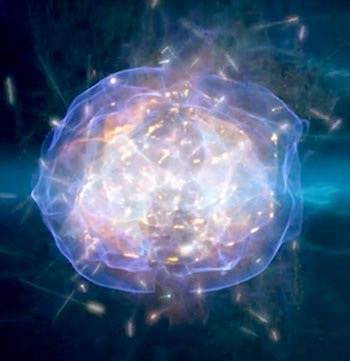|
home | what's new | other sites | contact | about |
||||
|
Word Gems exploring self-realization, sacred personhood, and full humanity
Quantum Mechanics
return to "Quantum Mechanics" main-page
from https://besharamagazine.org/newsandviews/silicon-by-federico-faggin/
Silicon by Federico FagginRichard Gault reviews the autobiography of the scientist who invented the silicon chip, and is now putting forward a new theory of consciousness Federico Faggin on a visit to Intel Headquarters in 2011. Photograph: Wikimedia Common Silicon is the story of a remarkable man, a genius, someone whose work has directly affected the lives of almost every human alive today. You have probably not heard of Federico Faggin, but he is the man who developed the silicon chip, the microprocessor at the heart of all electronic devices today such as your computer. He has done more. If you are using a touchpad to scroll through this review, then you owe another debt to him. This is his story told by himself, his autobiography. Why should you read this book? One reason is that we tend to unthinkingly accept the gifts that technology delivers. But behind every invention there is a human story, and anyone who naively imagines that technology evolves following the cold, relentless logic of science will discover in these pages that this is not how it happens. Rather, every new discovery is the outcome of battles between competing human forces – some good, some bad – and this book provides a first-hand account of this reality. Faggin had to fight hard and with great resolve to create the microprocessor. Then having finally succeeded, the very people who had failed to support him tried to take the credit and airbrush him from history. Knowing the story we can better appreciate what we have been given, and so have the chance to offer proper gratitude for it. But another and greater reason to read Silicon is to learn what Faggin still has to teach us. For this is a most unusual work. I have struggled to find the right way to describe it and the best I can manage is that this is a trojan horse of a book. But what emerges from this trojan horse are not armed soldiers out to get you: angels coming to your assistance would be a better description. The many people who have heard of the Intel 4004 and Z80 – computer scientists and electronic engineers – and will read Silicon for its insights into the technology, will not suspect when they open the book that it will be leading them into fundamental questions about consciousness and the meaning of life; and, in the final chapter, into a new theory of physics which posits that consciousness, not matter, is the ground of being. If you have never heard of the Intel 4004 (the name of the first microprocessor silicon chip) or the Z80 (a more advanced chip that Faggin developed and which is still in widespread use), then it is important that you are not put off by the technical details that Faggin necessarily provides in his account of their invention. You do not need to comprehend everything to appreciate that it was genius that recognised the potential of silicon, and heroism that was needed to realise that potential. You will also be given the opportunity to appreciate beauty where you may never have imagined it could be found. As an artist Faggin signed his design of the 4004. The Galileo Astronomical Observatory, La Specola Tower, at the University of Padua, Italy, where Galileo was Professor of Mathematics and Faggin took his first degree. Four Lives. The story of how he reached this fourth stage is fascinating. The novel technologies that he developed brought him great rewards, as you would expect and probably hope. As a man in his forties, he found himself in a situation where he had sufficient wealth to never need to work again. More than this, he had a loving wife, children he was proud of, the esteem of his peers, many good friends and a beautiful home near San Francisco. What he did not have was happiness. Why could he not be happy, he asked himself: why? – when, by all the criteria that contemporary society sets as benchmarks, he should have been one of the happiest of men. In part he recognised that he had for too long been putting work before family: long periods of 80-hour weeks had meant he had not given his wife and children all the love they deserved from him. But this alone did not seem to fully explain the depth of his existential despair. Seeking answers set him off on a spiritual journey. Alongside this, the work he was engaged in opened up questions he began to feel needed answering. In the 1980s the rapid development of computer technology was not delivering everything that had been expected of it a couple of decades earlier. There had been high hopes for Artificial Intelligence (AI) in the ’60s, but progress was disappointing despite the huge increase in computer power. There was some success in programming computers to recognise patterns, to which Faggin himself was contributing. When shown an apple, a computer could identify it correctly. But could a computer attach any meaning to the identified image? A person might respond with emotion – ‘I like apples’ – and feel a desire for one. Could computers be expected to feel? A professor of neuroscience pointed out that he was asking questions about consciousness: ‘It’s something that happens in the brain and one day we’ll understand it’ he was told (p.153). With these words consciousness became, and remains, a primary interest and concern for Faggin. He realised that he was encountering what has been called ‘the hard problem of consciousness’: how can matter possibly give rise to self-awareness? Consciousness, he came to recognise with increasing clarity and conviction, is the fundamental difference between human and artificial intelligence. (Faggin’s extended thoughts into this are found in Appendix 4, which is also available on line [/]. The latter years of his forties saw Faggin wrestling with unhappiness and beginning to seek answers to fundamental questions about what it is to be human. And then when he had just turned 50, he was granted an epiphany, an astonishing spiritual experience as brief as it was intense. Returning to bed after getting up in the night for a glass of water, he was overwhelmed by ‘a powerful rush of energy’ which emerged from his chest as ‘a broad beam of shimmering white light, alive and beatific’ which exploded ‘to embrace the whole universe’. He tells us that he: … knew, without a shadow of a doubt that this was the substance from which all that exists is made. This is what created the universe out of itself. Then, with immense surprise, I knew that I was that light. … The essence of reality was revealed to be a substance that knows itself in its self-reflection, and its self-knowing feels like an irrepressible and dynamic love.’ (p.160, original italics). Although Faggin describes himself as having had four lives, in actuality he has had just two which were separated by less than a minute: one before this intense encounter, and the other his life since. Before he was a materialist; ever since he has been an idealist (to use the terms used by Bernardo Kastrup). He grew up, as most westerners do, believing the world, including the human, to be made up of and explained by material matter and energy. Following his experience he understood himself to be: … that unique point of view with which One – All that is, the totality of what exists – observes and knows itself. I am a point of view of One, a portion of One indivisible from it. (p.161) An early (1971) Busicom calculator using an Intel 4004 processor (centre, bottom) in the National Museum of Nature and Science, Tokyo. The Physics of Consciousness. First, they need to be prepared to listen. With this book Faggin will introduce many hardened materialists to ideas they would not otherwise encounter. He is a respected figure in the world of electronics and computer science, and his credentials cannot be doubted. So if someone of Faggin’s rank can raise questions about the nature of reality perhaps, at the very least, he deserves being listened to. Secondly, having got people’s attention, it needs to be explained (convincingly) how material reality is not all there is. There is an essential problem here because, as Pascal – whom Faggin quotes – has said, ‘The last step of reason is to recognise that there are so many things that surpass it’ (p.162). But Faggin, as he has demonstrated again and again in his life, is not a man to shirk a challenge. Having come to the conclusion that consciousness is the sole ground of being, he has dedicated his energy and intellect to … developing a model of reality based on the assumption that consciousness is irreducible… a vision of reality in which the engine of evolution is the desire of a conscious universe to know itself. (p.192) The final chapter of the book outlines his model and in addition, just as he offered appendices with more technical details for those interested in microelectronics, he provides more detail of his theory of consciousness in the freely available Appendix 5 [/]. I am not going to present a detailed explanation of his theory here; we will be interviewing Faggin for the Beshara Magazine next month and will explore it in greater depth then. For the moment, I will limit myself to a few observations. Firstly, the fundamental difference between Faggin’s model of reality and the standard materialist one is that it recognises two distinct forms of reality rather than one. For Faggin there is both an inner reality, an interiority, as well as an exterior reality. The inner reality includes consciousness, but for science there is only the outer reality, and so consciousness appears to it simply as an aspect of the material world. A second significant feature of his model is the role he awards to free will. Free will is a tricky subject for a materialist. The simplest way for the them to deal with it is to deny its existence. After all, if consciousness is a product of material forces, then it is these forces which produce our thoughts and actions rather than ‘us’ – although this is not to say that materialism holds that in principle everything can be predicted; there are many so-called chaotic systems whose behaviour cannot be determined even though they obey physical laws (e.g. weather systems). This denial of free will is at variance with our own subjective experience, as well as bringing in its wake awkward questions concerning moral responsibility. However, in Faggin’s model free will is real and vital. An even more fundamental problem for materialists is the disappearance of the material from their universe. Scientific probing of atoms over the past century has led to the understanding that matter as conventionally understood (and commonly experienced) is not the basis of physical reality. For physics, ontology, as Faggin states, has moved from particles to quantum fields – fields of energy analogous (and related) to the fields of magnetic forces, or the fields which allow our smart phones to communicate wirelessly. These quantum fields are troubling for a materialist. How are they to be understood? They give rise to waves which when observed – and only when observed – manifest as particles, though where the particle will manifest cannot be predicted. By contrast, Faggin’s model explains the strangeness of the quantum world. More than that, it accords with our own experiences. We know ourselves to be conscious; we believe we make free choices and can express ourselves creatively; we see and experience a world which seems solid. And one more very important thing – unlike computers, we recognise meaning: we understand when a friend says that they like roses, that actually they mean, I’d really like you to buy some for me. U.S. President Barack Obama honours Marcian Hoff Jr., Federico Faggin (second left) and Stanley Mazor of Intel Corporation with the National Medal of Technology at the White House in Washington November 17, 2010. A Co-operative Future. Faggin acknowledges that he has drawn on the ideas of perennial philosophy. Students of Vedanta or the Islamic tradition of Ibn ‘Arabi will recognise many correspondences, such as his belief that ‘the driver of evolution is the urge of One to know itself’ (p.231, original italics). But, also clearly, the theory warrants further elaboration and, in so far as it can be, further evidence if it is to persuade sufficient scientists and philosophers to adopt it. He has recently presented a much fuller and more technical account [/] which uses a novel form of mathematics which he and his co-author Giacomo Mauro D’Ariano claim ‘represents a new Galilean revolution for the scientific method’ (op.cit, p.21). It would be a delightful irony if Faggin, as a graduate of the university where Galileo taught (Padua), were to succeed in undoing Galileo’s ‘error’ (see my Beshara Magazine article) that led to science ignoring consciousness. Faggin recognises that ‘the “system” will forcefully defend the status quo’ (p.231), so this will not be easy to change the current scientific paradigm. To this end, together with his wife Elvia (the great woman behind a great man), he has established the Faggin Foundation [/] to support academic understanding of consciousness through theoretical and experimental research. This is a relatively short book but, mirroring his life, Faggin covers a lot of territory. It begins in the land of his birth, an Italy which he describes as pre-industrial: oxen still dragged the peasant farmer’s plough. It concludes with a vision of a post-materialist future – a future in which the Baconian imperative to master nature has been abandoned. Instead, cooperation will be its hallmark. It is a future where we are not slaves to technology but where technology serves to enhance our potential. In between, he offers us the chance to better appreciate the technological world we live in, and offers us keys to better understanding ourselves.... Silicon: From the Invention of the Microprocessor to the New Science of Consciousness by Federico Faggin, was published by Waterside Productions in 2021. 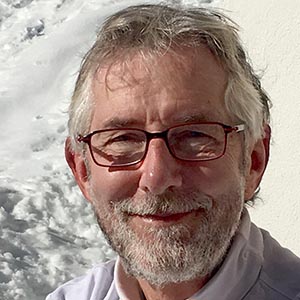 Dr Richard Gault has worked at universities in Scotland, Ireland, Holland and Germany, where he has taught and researched a variety of subjects, including the history and philosophy of science and technology
**********************************************
from https://besharamagazine.org/science-technology/consciousness-as-the-ground-of-being/ Consciousness as the Ground of Being Physicist Federico Faggin talks about his new theory which puts our inner experience and the desire to know ourselves at the centre of reality 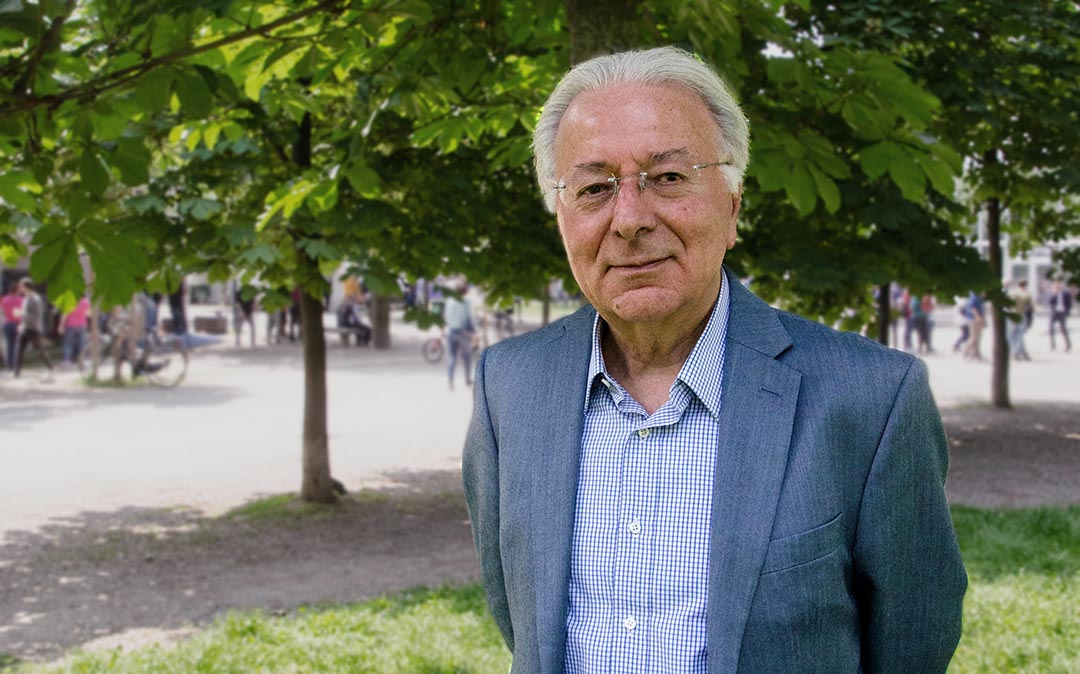 Federico Faggin is a physicist and entrepreneur who made his name – and his fortune – as the inventor of the world’s first microprocessor, the Intel 4004 chip, which is the device at the heart of all our computer technology. In his later life, he has turned his attention to the study of consciousness, and in 2011, with his wife, he founded the Federico and Elvia Faggin Foundation [/] which is dedicated to supporting research into its nature and origin. With Giacomo Mauro D’Ariano, he has now developed a new physical model of reality in which consciousness, not matter, is seen as the foundational principle. We have already reviewed his autobiography, Silicon,[1] in the magazine (click here); in this interview, conducted by Richard Gault and Jane Clark via Zoom at his home in Silicon Valley, we had the chance to ask him further about his theory and its implications for our understanding of human life.
Richard: Can we begin by covering some of the ground that was in Silicon, by asking how you moved from being a businessman working in computer technology to someone with an interest – indeed, a passion – for research into consciousness. Federico: My interest in consciousness began in the mid 80s, when I started a company to develop artificial neural networks – or rather, emulators of neural networks – so that we could create systems that could learn by themselves. I was studying neuroscience and biology, and I asked myself: ‘How come that all these books never mention consciousness?’ It seemed to me that consciousness cannot be the same as the electrical signals or the biochemical signals that I read about in those books. So I asked: ‘How can we go from electrical signals to feelings? What would it take to make a conscious computer?’ The problem began to haunt me, but I had to try to figure it out in my spare time because solving it was not the objective of the company. And after a while – I mean probably about half a year or a year – it became very clear that what I was asking was impossible to do. Also, in those days, I was not happy. I had achieved everything that the world says should make us happy: I had a beautiful family, we were all healthy, and I was rich and famous. What more could I want? But I was unhappy and for a long time I was unwilling to admit it to myself. Eventually I realised that in some deep recess of my being, of my psyche, I was really screaming. And so, I was unhappy without knowing why, and at the same time I was trying to understand what consciousness is. I didn’t know then that the two things were related; for one seemed to be a scientific problem and the other was a deep inner feeling. Richard: This was the time when you had the experience of love and unity you describe in your book? Federico: Yes. It happened during a vacation at Lake Tahoe. We had a home there and were spending the Christmas holidays skiing. I woke in the night and suddenly, to put it very briefly, I experienced myself as love. It felt like an unbelievably strong and powerful love – an energy which was both scintillating white and self-knowing – and it was coming from me. This I found extraordinary, because I didn’t know then that such love could emerge from me, or from anybody. And so I was stunned. Then this energy exploded, and I saw that everything is ‘made’ of that same love. I experienced myself as the world made of that energy observing myself, and that was mind-blowing, because I had always experienced myself as separate from the objects of my observations. But suddenly I was both the observer and the observed. It was a very short experience, but it changed my life. It gave me a taste that there is more to reality than what I knew. Richard: So that took you into exploring consciousness? Federico: That experience set me onto a path of deeply wanting to understand what consciousness is. But we cannot know that by reading books; we can only do it by actually experiencing it – by knowing it on a first-person basis, not by looking into a microscope. So, for the next 20 years I tried to figure it out by having all kinds of different experiences, many equally extraordinary as the first, and that gave me a sense of the shape and boundaries of consciousness. It was already clear in my original experience that consciousness must be fundamental, but as time went on it also became clear intellectually that consciousness cannot be something that happens ‘inside’ the brain. It has to be what creates brains. And so, with that sense, I decided about 12 years ago to dedicate myself to the scientific study of consciousness. This will be my last project before I move on to the other side, I told myself. And now I am immensely happy about what I’m doing. Jane: Can I ask you what you did in the 20 years after your first experience to build upon what you had discovered? Did you undertake meditation, for instance? Or turn to the teachings of spiritual writers? Federico: I did all of those and then some. First, I tried to understand with a transpersonal therapist what was going on. I went through different kinds of experiences that she recommended, like special types of massage that find areas of the body that have traumas in them, and various forms of biofeedback. Then I went on a 10-year adventure with the Diamond Heart Approach [/], which is a school – a psycho-spiritual school – during which I had many illuminating experiences. And of course I did meditation – of all kinds. I also wrote thousands of pages of introspection and explored many subjects through reading, because after I had certain extraordinary experiences – I had a spontaneous out-of-body experience, for instance, and many vivid dreams – I followed them up with reading and found that many other people had similar ones. You could say that I went with the punches. But at the same time, I feel that there was a wiser part of me that was guiding the process – bringing forth whatever I needed at that time to make progress. I believe we have a guide within; we are not alone but are part of a vaster reality that we do not see with our eyes but can sense with an open heart.  Lake Tahoe in California where Federico had his life-changing experience of unity in December 1990.
The Desire for Self-knowledge. Federico: There are of course many models that try to explain reality. Many of them are philosophical or metaphysical, but they are not generally connected with physics. But I’m a physicist, and so whatever model I come up with, I think it must also accommodate what we know about physics. So that is the main difference. In the Big Bang cosmology the universe has emerged from what physicists call ‘the quantum vacuum’, which is in itself deeply mysterious. The idea is that out of this vacuum come fluctuations which are unpredictable, and one of these unpredictable events created the universe. But in my model, everything emerged from this scintillating, white energy which I saw so clearly in my first experience. That energy has an inner reality – a conscious, semantic reality – and an outer symbolic reality made of matter, just like all humans have, and, I believe, all living organisms. What is the essence of matter? Physicists are now pretty much agreed that it is information. We have found that essentially the particles – the atoms and molecules – that we thought constituted ‘stuff’ don’t exist as objects at all. They exist only as states of fields – the fundamental quantum fields – which interact with each other and then create everything else. The main point here is that these elementary particles are not separate from the quantum fields. We think we live in a world where there are objects – separate entities – which interact with each other in space and time. That has been the traditional worldview of science. But nowadays we have to think of objects as states of fields; they interact with each other, but at the same time they are not separate from the field. In the model I am proposing these quantum fields are conscious. Richard: So in your model, the fundamental energy can know itself as interiority, and it can also know itself as information, that is, as matter, so that when another entity like itself looks at it, it seems to be a separate individual thing. Federico: Yes. But to understand the overall situation, we have to imagine that everything is made of an undivided energy that has the desire and the capacity to experience and know itself. I call this unified field ‘One’. One exists ‘before’ the physical universe, though what physicists call the ‘physical universe’ is the informational aspect of reality. The semantic aspect of reality is the inner experience and knowing of One, which current physics does not recognise. Moreover, One exists in a vaster reality that contains the space–time reality we experience. Out of One emerge conscious entities that, like One, have the desire and capacity to know themselves. Imagine each entity as a point of view or perspective that One has about itself. They are not separate from One, though their conscious experience is private. To know each other, these entities need to communicate, and to communicate they need symbols, like the words we use. Each entity is like a quantum field and the symbols are like the states of the quantum field, what we call physical particles. So, the entities are the conscious fields, and they shape symbols within their own fields to communicate with other fields – other entities. The crucial difference with contemporary physics is that these fields have an inner semantic and conscious experience, just like we do. The symbols have meaning that are understood by the conscious fields. Jane: So this urge to know is not only at the level of the absolute reality; it appears in every individual conscious entity? Federico: Yes, the fact that we have interiority is primary in our model. Consciousness and free will are foundational and exist from the beginning rather than emerging with the physical brain. In this model, it is the brain that emerges from the conscious fields as an informational-only structure. The meaning of the information exists in the conscious field which is what we really are. Matter is nothing more than the information that conscious entities use to communicate with each other to know themselves. Richard: Obviously it is true that we communicate through matter. I know you through the way that you appear, through the words you speak and the things you do as a physical entity. But why not just have direct communication between our interiorities? Why go to all this bother of creating matter, which in a way puts up a barrier between us? Federico: I asked myself the same question many years ago. Firstly, each of us has an inner experience that is private and inviolate, whereas symbols, like matter, are public and can be perceived by everybody. To maintain my identity – the uniqueness of my point of view – my experience cannot be identical to yours. If you could directly know my experience, and I yours, we would be the same entity. And secondly, the need to convert my meaning into symbols to communicate with you, as well as my need to convert your symbols into your intended meaning, allows me to know both myself and you much better. So I see this universe as playing the role of a kind of virtual reality, allowing us to know ourselves better when our consciousness is embodied into living organisms. The process is driven by the fact that this reality beyond space and time wants to know itself. And we have constructed this universe to better know ourselves by using a body that amplifies those traits we wish to explore and comprehend. Jane: So what you’re saying, fundamentally, is that something that we might already know interiorly appears differently or more completely when we actually experience it played out in the physical universe? Federico: That’s correct. But it’s important to add that this ‘playing out’ can never completely express who we are; there is always something that is left out because we are potentially infinite. We communicate with symbols, and the symbols are never sufficient to capture all that we are. They are limited. The evolution of the universe we witness is the other face, the symbolic aspect, of the endless search for meaning of all the conscious entities in existence. Think about the love that we may feel for a person. Can we ever express that love all the way? No, we cannot. We may try to do it in poetry, in music, or in painting. Whatever way we try, we will always come up short. No symbolic expression will ever capture the totality of what we are feeling. Our feelings give us the sense of who we are. They tell us what we still have to know about ourselves, which is the unexpressed meaning we feel within; the urge that pushes us to know ourselves ever more. That urge manifests as curiosity, as courage, and as adventurousness, driving us toward the unknown. Richard: You have said that One will never cease its expression. So this process of coming to know will never actually come to an end. Federico: It will not because One is potentially infinite.
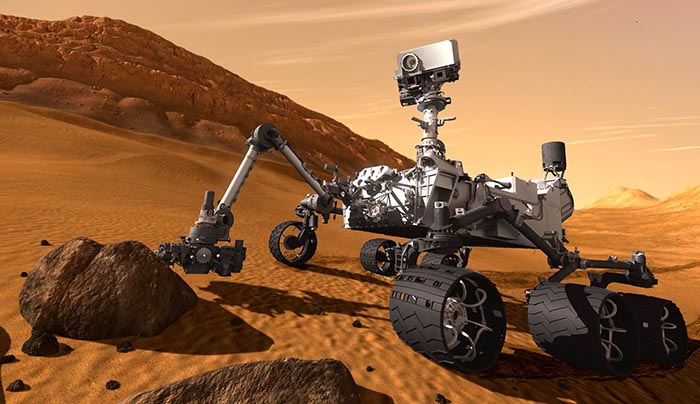 Extending human potential: artist’s concept of a ‘robot geologist’ on the surface of Mars. NASA sent two of these Exploratory Rovers, named Opportunity and Spirit, to Mars in 2003, each with the mobility and toolkit to collect and analyse rocks sample. The Promise and the Dangers of AIRichard: As I understand it, you believe that this urge for self-knowledge is what distinguishes human beings from machines; you think that it could never manifest in any form of artificial intelligence. Federico: Many physicists believe that consciousness is just an epiphenomenon of the brain, and this crucial misunderstanding is at the root of the idea that artificial intelligence will eventually be more intelligent than we are. The thing we need to remember about AI is that we created it, and we did this for the same reason that I have already mentioned – because deep down, we want to understand ourselves. If we don’t understand this, then we are doomed. Jane: Why doomed? Federico: Because then we believe we are machines instead of spiritual beings. And if we believe that, there can always be better machines which eventually can dominate us – especially since we also have come to believe that evolution is about the survival of the fittest. With these two beliefs combined, there will always be war between human beings and machines, and humans will likely lose because we have forgotten and discarded what makes us more than a machine can ever be. Richard: But from what I have read, it seems that you very much draw upon the idea of technology in your vision of the future. You see a way for humanity to interface with computers, using methods which are at present unknown but theoretically possible, and in doing so, bring out more of our potential. Federico: Yes, absolutely! But only if we acknowledge and develop our spiritual dimension. Technology is the greatest gift and it has complementary aspects to our own abilities, but it can be beneficial only if it is used to deepen the understanding of who we are as spiritual beings. Otherwise, it may be used to enslave the rest of humanity by people of evil intent, and end up destroying even them. We are beings of light that can know other dimensions of existence way beyond what algorithms can do. The linking of human beings and technology is already happening. Elon Musk is already trying to create interfaces – direct interfaces – between biology and computers. Can it work? Of course it can work. Our body is physics. There is nothing non-physical about it. What is non-physical, or perhaps I should say ‘extra-physical’, is our consciousness, our identity and our free will. And this brings me to the theory I developed with one of the top physicists in the world in the area of quantum information. 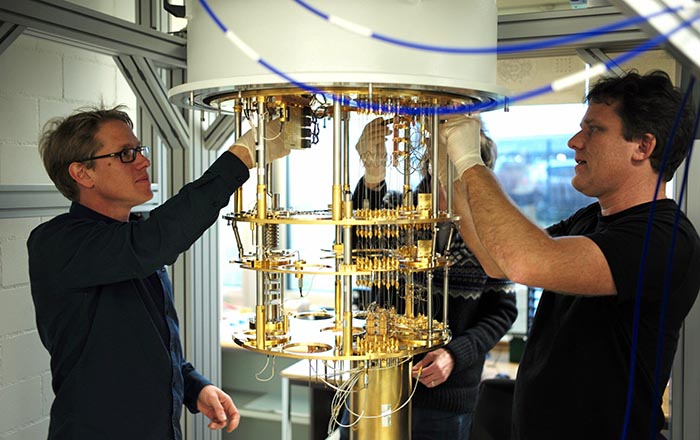 Scientists at the IBM Research Lab in 2017 with their prototype 50-qubit quantum computer. IBM’s latest version, announced in November 2021, is 127-qubits. Quantum computers are still at an early stage of development and are not yet outperforming classical computers. Consciousness and Quantum Reality. Federico: Yes. Up until now, quantum reality has been considered by many physicists to be just an abstraction – a mathematical description that allows us to predict the probability of things we can measure in space–time. But in the last 20 years, we have begun to build quantum computers, and these operate in a way that is impossible for classical computers; they can do simultaneous computations that would have to be done serially with classical computers. Now it’s one thing to say that there is an abstract quantum world that allows us to make probabilistic predictions. But it is another thing to say that we can do computations in an abstract world and get the result in our physical world. To do computation, the quantum world must be real somehow. Most people working in the field don’t worry about what’s going on at a deeper level; they just want to develop faster computers. But it is important for us, because now we have established that the quantum world is real, we can also say that it is the realm where communicating conscious entities exist and have their own experiences. This is the basis of our model, which is actually now a theory, and will be published in a book entitled Artificial Intelligence vs Natural Intelligence that should come out shortly.[2] (The full article is already available online, click here [/].) The first author is Giacomo Mauro D’Ariano. He is a physicist and an expert in quantum information, who has been able to show that quantum physics derives entirely from quantum information. From quantum physics we then derive what we can measure in our physical world. So, in this theory, consciousness does not arise from the information generated in the physical world. It is instead a quantum phenomenon that creates the information that we then perceive as the physical world. Richard: What do you mean by quantum information? Federico: Classical information is about ‘bits’; about things being in one of two possible states, 0 or 1, true or false. A ‘bit’ is a human construction out of which we can create computers. But in the last 20, 30 years, scientists have figured that there is something equivalent to a ‘bit’ in the quantum world, called a ‘quantum bit’ or ‘qubit’. The qubit is represented, for example, by what is called the ‘spin’ of electrons. Spin can only be represented in a special space called Hilbert space, which is a multidimensional space where each dimension is represented by a complex number – meaning, a number which is the sum of a real and an imaginary number. The qubit exists as an infinity of states in Hilbert space, but when it manifests in space–time, that is, when it is measured in our physical world, it appears only as two states – zero or one; up or down; left or right; forward or backward – depending on the choice of direction of the magnetic field in which you measure this spin. So each qubit represents an infinity of states, although when they manifest in space–time they show up as a classical bit. Qubits also have the property of being able to ‘entangle’. Entanglement is a property that exists only in quantum systems. It means that if two qubits interact, they can get into a joint state which continues to exist even if they are moved apart from each other in space. This results in mind-blowing phenomena such as instantaneous correlations irrespective of their distance between two entangled electrons which are physically separated. (For more on quantum entanglement, see the video right or below.)These two properties together mean that a qubit can form ‘connections’ which are not possible in classical space–time. This means that quantum reality is much vaster than the reality we are aware of in our normal experience. Jane: So, basically, in this model, consciousness or interiority is located in the quantum world, which comes ‘before’ the physical world – in fact, it is generating it. Or more specifically, we can say that in the quantum world, there are conscious entities which, because of their desire to know themselves, are creating the physical world as information. Federico: Yes. And one of the most important aspects of this theory is that it provides for the first time a foundational understanding not only of consciousness, but also of the nature of free will. Free will goes hand-in-hand with consciousness and can be explained by the different nature of probability within quantum systems compared with classical systems. These entities, these ‘monads’ or consciousness units, have consciousness, free will and identity. Their identity is that they know themselves as the ones who are having the experience. They also have the capacity for action, so they have agency. Putting all this together, we now have the beginning of a theory that can be falsified: therefore we can begin to imagine experiments to make. 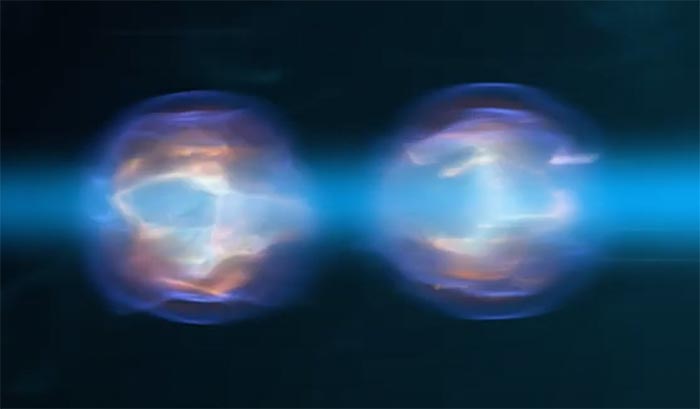 Quantum Entanglement refers to a phenomenon in which two or more quantum particles remain connected to each other – and seem to communicate with each other instantaneously – even when they are separated in space. Image; from video How Do Scientists Explain Quantum Entanglement? The Generation of Meaning.Richard: One of the things that your model solves is the separation between matter and consciousness that Descartes introduced. The two realms of the interior and the exterior – or in your way of saying it, the quantum world and the physical world – are always connected because the physical world is an appearance, a more limited representation, of the interior world. Federico: True. But it is important to also understand that we have to go beyond the quantum world described by physics if we are to understand where meaning comes from. Information in itself – whether we are talking about bits of qubits – has no meaning in physics; we give it meaning. A computer can learn to manipulate symbols, but it can never understand what their meaning is. So where is the meaning coming from? It comes from the actual experience – the ‘qualia’ – and in our theory, having a qualia experience occurs when a quantum system is in a coherent state, which we call a ‘pure state’. We have already said that information is the outer aspect of a conscious entities, so qualia are what quantum information represents. So we have a kind of Russian doll situation. The larger doll is the experience itself. From this conscious experience emerges quantum information; from quantum information emerges quantum physics, and from quantum physics emerges classical physics. And all of them are interconnected. But even though it is true to say that qualia are the inner, private aspect of reality and information is its outer, public aspect, you cannot separate the two. One of the postulates that D’Ariano has made is that when a quantum system is in a ‘pure’ state, that system is aware of being in that state, meaning that it ‘feels’ that state. One of the interesting properties of quantum information is that it is always unique – it is not comparable to anything else because it cannot be copied. So it has exactly the characteristic that we expect from consciousness, which is the privacy of personal experience. Our experience is inviolate; we can express it with symbols, words, grimaces and so on, but we are the only ones who know the quality and depth of what we feel. Our feelings have a sort of infiniteness to them because they are bottomless; they have no boundaries. Richard: I notice that one of the aims of the Faggin Foundation is the creation of a new mathematical theory of consciousness that can make testable predictions. And it sounds as if the work that you and Giacomo have done has indeed led to this. Federico: It is important to say that we cannot prove – could never prove – directly the assumptions that we made in coming up with the theory. This new theory describes a much vaster reality than anything we can test by instruments which operate in space and time. All we can test are the consequences of those assumptions which are measurable in space–time. That is sufficient to falsify the theory, and, as you know, being able to falsify a theory is the basis of its being scientifically acceptable. 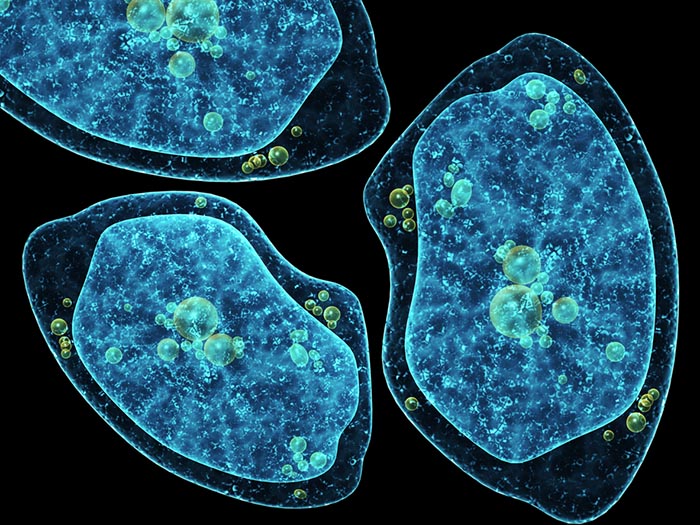 3D rendering of amoebas – unicellular creations with the ability to move, change shape, capture food and reproduce. The Primacy of Consciousness. Federico: Well, in this theory, the quantum fields are the conscious entities. But the particles are not conscious because they don’t really exist as separate things; they are just states of those fields. They cannot be conscious because they do not have a unique identity. Similarly, we think of ourselves as conscious bodies. But we are only conscious because our bodies are connected with conscious entities that exist in a vaster reality of which space–time reality is just a projection. So what I am – the real ‘me’ – lives in this vaster reality and it controls my body top-down. Our body is not conscious; it is made of electrons, protons, and so on, and it exists as information, as quantum-classical information. The simplest structure in the physical world that can host consciousness is a cell. Nothing less than a living cell can have its own consciousness in the sense that the physical structure can be controlled by a conscious entity. Jane: So if we do not really exist in space time, but at the level of this vaster reality, physical death should not fundamentally disrupt our consciousness? Federico: Yes, absolutely. We think that when the body dies, it is the end of our consciousness because we have been told that consciousness is produced by the brain. But as I said earlier, it is the other way around. It is the brain that is produced by consciousness. So consciousness uses the body as a tool to know itself. Clearly our body is temporary, but we are not temporary because we exist outside space–time and we want to know ourselves. And we will continue to seek to know ourselves ever more, for, as I said earlier, the process will never end. Our identity may transform itself, but we never die. We are quantum entities, and a consequence of this model is the idea that we exist in what we might call ‘eternity’. When our body dies, we don’t go anywhere because, in a way, we never were ‘here’. Richard: Could this idea not lead to a kind of fatalism. If I am not my body, and you are not your body, why should I look after you or care about you? Federico: Well, if we are all part of a holistic One, how can we be separate from each other? If you experience yourself as the world that observes itself, you will directly know that you are me and I am you. So, it could never happen that I would not care about what happens to you because what happens to you also happens to me. But the only way to understand this is not intellectually. It can only occur through an experience of union, because until I had that experience of love, I could have said exactly what you just asked. Richard: You had that extraordinary experience at Lake Tahoe and in the space of less than a minute, you knew things that you hadn’t known before. But does this mean that unless someone has a similar experience, they cannot understand fully what you are talking about? Federico: In a way, yes. As embodied conscious entities we forget our true nature as soon as we identify with our bodies. Yet, when we experience our true nature again, we recognise ourselves in that experience. If you want to find out, open yourself up to finding out, and you will be given the experience by yourself and no one else. I believe it was the vaster ‘me’ who gave me the Lake Tahoe experience because I wanted to find out for no other reason than knowing – not because I wanted to make a computer out of it, or make money, or whatever. If you want to just know for knowing’s sake, you will come to know. Period. Jane: One final question. There’s no doubt that we’re facing some sort of crisis in the world at the moment; we have an ecological crisis, a Covid crisis, a human crisis and there seem to be few solutions on the horizon. Do you see the kind of change of perspective you are talking about as an essential way forward for humanity? Federico: Yes, I think so. The fact is that experiences like mine are not rare now. Look at the many near-death experiences that have been reported: hundreds of thousands of people in the world have had them. A near-death experience is the closest thing to my experience, though it requires a physical trauma. Many people who have had such an experience have been changed by it, exactly as I was. So this quickening that is going on right now is an indication to me that humankind is ready to understand where we are, where we’re coming from, and what’s going on. I’m helping a certain community to get the message. Other people are helping other communities. And so there are many of us that are ready to understand and move beyond the illusion of being just a physical body. In the end, self-knowing and being are the same, so the only way to really know is to become what you know. Consciousness is what allows us to become what we know. 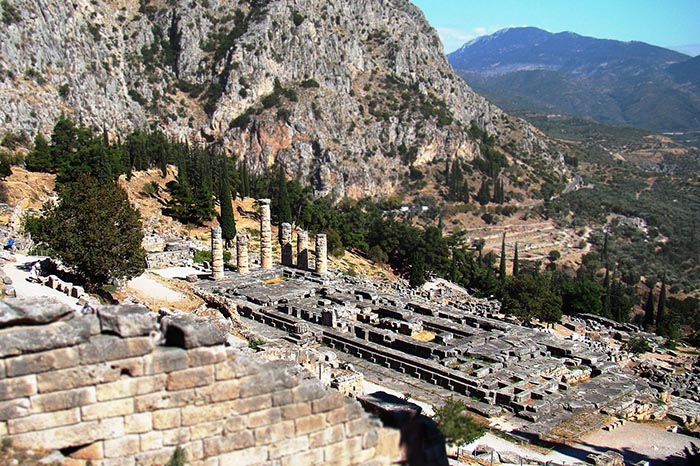 The Temple of Apollo at Delphi, Greece, where, according to Socrates – who adopted it as a central principle of his philosophy – the words ‘Know Thyself’ were inscribed over the entrance.
|
||||
|
|
